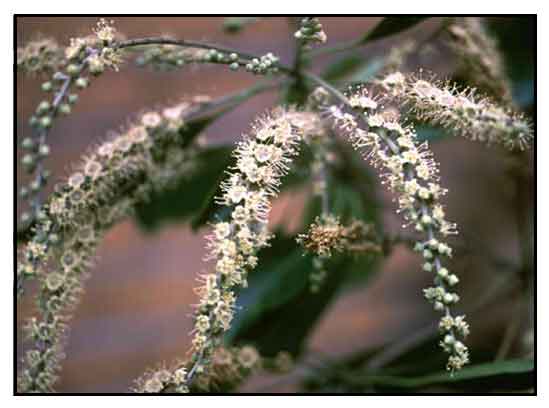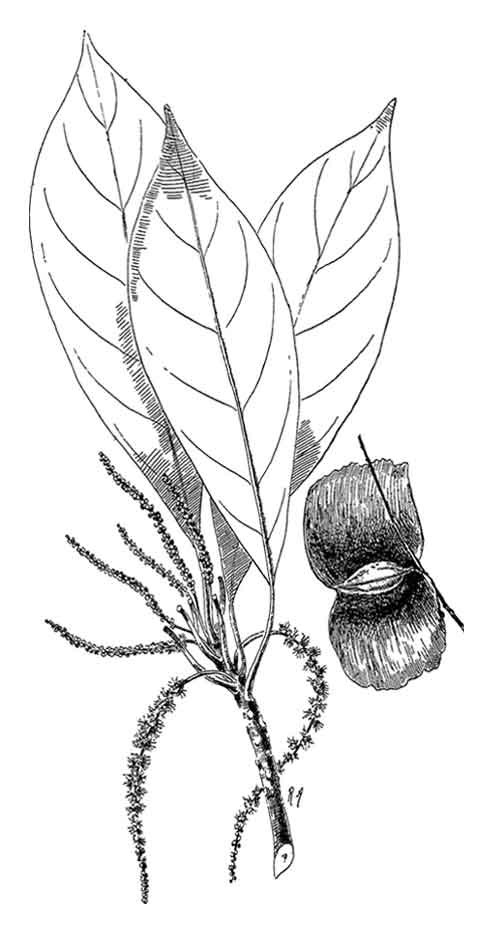
Family • Combretaceae
Kalamansanai
Terminalia calamansanai (Banco) Rolfe
PHILIPPINE ALMOND
Ma ni la lan ren
| Scientific names | Common names |
| Gimbernatia calamansanai Blanco | Anarep (Ilk.) |
| Pentaptera mollis C.Presl | Bagabo (Ilk.) |
| Pentaptera pyrifoliia C.Presl | Bangkalauan (Tag.) |
| Terminalia calamansanai (Blanco) Rolfe | Bangkalauag (Bis.) |
| Terminalia blancoi Merr. | Bangkalduag (Tag.) |
| Terminalia latialata C.T.Whhite | Bisal (Pang.) |
| Terminalia molliis S.Vidal | Bunlos (Tag.) |
| Terminalia oryzetorum Craib | Burauis (Kuy.) |
| Terminalia papilio Hance | Busili (Pang.) |
| Dikang (Pamp.) | |
| Kabañgasbañgas (Bag.) | |
| Kalamansali (Sbl.) | |
| Kalamansanai (Sbl., Tag.) | |
| Langkog (Mbo.) | |
| Langkug (C. Bis.) | |
| Lumanog (C. Bis.) | |
| Magtalisai (P. Bis.) | |
| Malakalumpit (Tag.) | |
| Pangalusiten (Ilk.) | |
| Saget (Ig.) | |
| Sakat (Tag.) | |
| Saket (Ilk.) | |
| Salisai (Lan.) | |
| Saplid (C. Bis.) | |
| Subo-subo (Tag.) | |
| Yankug (Mbo.) | |
| Philippiine almond (Engl.) | |
| Yellow terminalia (Engl.) | |
| Terminalia calamansanai (Blanco) Rolfe is an accepted name. Plants of the World Online | |
| Correction: Previously entered as synonyms, Terminalia calamansanai (Blanco) Rolfe and T. bialata are separate species. | |
| Other vernacular names |
| CHINESE: Ma ni la lan ren (Taiwan). |
| MALAYSIA: Mentalun, Mentalun batu, Batalong, Jelawai mentalun, Kedah tree, Ketapang. |
| MYANMAR: Lein, Leni. |
| THAI: Sakuni, Tinnok, KHIMOT. |
| TRADENAME: Terminalia. |
| OTHERS: Kako, Kwako, Sualisualo. |
|
Gen info
Distribution
- In most islands and provinces from the Babuyan Islands and northern Luzon to Palawan and Mindanao. - Native to the Philippines and the South Pacific Islands. - Reported in Indo-China, Myanmar and Thailand. - In deciduous forests, on roadsides, also near the sea, at low and medium altitudes. - Cultivated in NE India.
Availability |
Updated October 2024 / October 2021 / December 2015 / November 2013
![]()
 |
PHOTOS / ILLUSTRATIONS |
| IMAGE SOURCE: / Terminalia calamansanai / Photograph by: LiChieh Pan / Creative Commons: Attribution-NonCommercial-NoDerivs 2.0 Generic (CC BY-NC-ND 2.0) / click on image to go to source page / Useful Tropical Plants |
| OTHER IMAGE SOURCE: Fruit with spreading wings / hljh.tcc.edu.tw/teach |
| OTHER IMAGE SOURCE: Flowers / Racemes / hast.sinica.edu.tw |
| OTHER IMAGE SOURCE: Illustration: Terminalia calamansanai / Sir Dietrich Brandis - 1824-1907 / Wikipedia |
Additional
Sources and Suggested Readings |
α• |
DOI: It is not uncommon for links on studies/sources to change. Copying and pasting the information on the search window or using the DOI (if available) will often redirect to the new link page. (Citing and Using a (DOI) Digital Object Identifier) |
| List of Understudied Philippine Medicinal Plants |
| New plant names needed The compilation now numbers over 1,500 medicinal plants. While I believe there are hundreds more that can be added to the collection, they are becoming more difficult to find. If you have a plant to suggest for inclusion, native or introduced, please email the info: scientific name (most helpful), local plant name (if known), any known folkloric medicinal use, and, if possible, a photo. Your help will be greatly appreciated. |
• |
 |


 Botany
Botany • Growth form: A tree, up to 40 m tall, with buttresses (up to 10 m tall). Trunk: Bark is grayish to yellowish brown and shallowly fissured. Foliage: Leaves are leathery, elliptic to obovate shaped (8 – 20 cm long and 3 – 9 cm wide) with 4 – 8 pairs of veins, pointed tip and tapering base. Young leaves are hairy on the underside, and slowly becoming smooth as they mature. Sometimes, mature leaves may retain hairs on the underside of the leaves. Leaf stalk is 1 – 4 cm long, and usually have 2 glands. Old leaves turn yellow when shed. Flowers: Inflorescence occurs at the axillary and comprises of many small flower (about 0.2 cm long). Flowers are cream or greenish yellow color with a strong musty smell. Calyx is cup-shaped with triangular lobes and hairy tube. Disc is densely hairy while style and filament are smooth. Fruit: Fruit is velvety and variable in shape and size, but usually 1 – 3 cm long and 2 – 10 cm wide. Fruit has 2 broad side wings (1 – 2 cm long and 2 – 4 cm wide) and a triangular body. (
• Growth form: A tree, up to 40 m tall, with buttresses (up to 10 m tall). Trunk: Bark is grayish to yellowish brown and shallowly fissured. Foliage: Leaves are leathery, elliptic to obovate shaped (8 – 20 cm long and 3 – 9 cm wide) with 4 – 8 pairs of veins, pointed tip and tapering base. Young leaves are hairy on the underside, and slowly becoming smooth as they mature. Sometimes, mature leaves may retain hairs on the underside of the leaves. Leaf stalk is 1 – 4 cm long, and usually have 2 glands. Old leaves turn yellow when shed. Flowers: Inflorescence occurs at the axillary and comprises of many small flower (about 0.2 cm long). Flowers are cream or greenish yellow color with a strong musty smell. Calyx is cup-shaped with triangular lobes and hairy tube. Disc is densely hairy while style and filament are smooth. Fruit: Fruit is velvety and variable in shape and size, but usually 1 – 3 cm long and 2 – 10 cm wide. Fruit has 2 broad side wings (1 – 2 cm long and 2 – 4 cm wide) and a triangular body. ( Constituents
Constituents